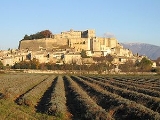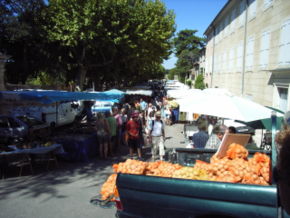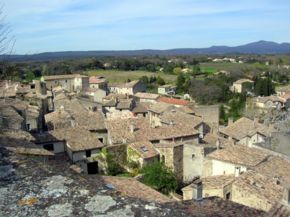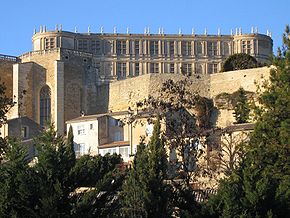
Grignan
Encyclopedia
Grignan is a commune
in the Drôme
department in the Rhône-Alpes
region
in southeastern France
.
It has a magnificent Renaissance castle and is mentioned in the letters that Madame de Sévigné
wrote to her daughter, Madame de Grignan
, in the 17th century.
department, and close to Mont Ventoux
, the highest mountain in Provence
.
To visit Grignan, take the A7 autoroute
and use either exit #18, Montélimar
Sud, or #19, Bollène
.
 The main crops produced in the area are lavender
The main crops produced in the area are lavender
, truffles, wheat
, and sunflowers. Nearby is the village of Nyons
, world famous for its olive
s.
 Several archeological excavations have shown that the rocky promentory of Grignan has been occupied since the Iron Age
Several archeological excavations have shown that the rocky promentory of Grignan has been occupied since the Iron Age
. There is evidence of a former Bronze Age
society here, as well as Roman occupation in the 5th and 6th centuries AD.
Historians have noted that in the year 1035, a cartulaire (a ledger of church or monastery property titles) from the Abbey of Saint-Chaffre in the Haute-Loire, makes mention of an obscure castellum Gradignanum. Over the next century, the name steadily evolved to become the castrum Grainan (1105), then Graigna, Grazinam ... We know very little about the birth of the castle or those who built it. The existence of a certain Christophe de Grignan has been established some time around the year 1030, and in 1035, the cartulaire of Saint-Chaffre, speaks of a 'Rostaing du château de Grignan,' Rostagnus de castello Gradignano.
A century later, according to various documents, the Grignan family appears to have become well established. It is precisely during this time that the Grignans seem to have lost the ownership of the castle which bears their name. Beginning in 1239, the records show that Grignan ceased to belong to the Grignans ... but to the Adhémar de Monteil family.
The expansion of the castle coincided with the rise in power of the Adhémars of Grignan. The Adhémars were up-and-coming so their castle necessarily had to follow. Beginning in the 13th century, the Adhémars rose from Barons to Dukes, finally being elevated to the rank of Counts by Henry II, King of France
. Grignan Castle progressively became an imposing stronghold. The Adhémar family line ended when Louis Adhémar died without an heir in 1559. The titles and possessions of Louis Adhémar, Count of Grignan, fell upon his nephew Gaspard de Castellane, son of Louis' sister Blanche Adhémar. Although the Adhémars were an illustrious family, in terms of sheer glory they were rivalled by the Castellane clan.
The castle was eventually inherited by François de Castellane-Ornano-Adhémar de Monteil de Grignan, who carried among his titles the Duke of Termoli, Count of Grignan, Count of Campobasso, and the Baron of Entrecasteaux, as well as a knight in the service of King Louis XIV
. He was governor general of Provence, and through the Dutch of their cíty of Orange.
François, the last Count of Grignan, was two-times a widower (his wives Angélique-Clarisse d'Angiennes, daughter of the Marquis de Rambouillet, and Marie-Angélique du Puy-du-Fou having died in quick succession). For his third marriage, he chose a certain Françoise-Marguerite de Sévigné, daughter of the marquise of the same name whose illustrious letters have perpetuated the memory of her son-in-law—and his castle to this very day.
Madame de Sévigné travelled three times to Provence (that is to say, Aix
and Grignan) in order to spend time with her daughter and son-in-law: a 14-month stay beginning in 1672; another 14 month stay beginning in 1690 taken before a quick trip to Brittany; and a third stay of 22 months leading right up to her death in 1696. In other words, Madame de Sévigné spent only a little less than four years total in the part of France which occupied so much space in her heart and letters.
 Louis Adhemar, governor of Provence, remodelled the medieval castle from 1545 to 1558. From 1668 to 1690, François de Castellane-Adhemar turned it into a sumptuous Renaissance
Louis Adhemar, governor of Provence, remodelled the medieval castle from 1545 to 1558. From 1668 to 1690, François de Castellane-Adhemar turned it into a sumptuous Renaissance
palace.
Construction on the site of Grignan's present castle was originally begun in the 12th century, but it wasn't until the 13th century that the Adhémar family expanded it into a mighty fortress. In the 17th century, François Adhémar de Monteil transformed the fortress into a luxurious residence. Reduced to ruins in 1793, it was reconstructed in the early 20th century by Madame Fontaine who spent her entire fortune to restore the castle to its former grandeur. Presently, the castle belongs to the Drôme and is a major tourist attraction.
was constructed between 1535 and 1539 at the request of Louis Adhémar. The Renaissance façade is flanked by two square towers and a beautiful Gothic rose window. Inside is an impressive 17th century altar and organ loft. On the floor in front of the altar is a marble funerary stone marking the sealed entrance to the tomb of Madame de Sévigné
.
Communes of France
The commune is the lowest level of administrative division in the French Republic. French communes are roughly equivalent to incorporated municipalities or villages in the United States or Gemeinden in Germany...
in the Drôme
Drôme
Drôme , a department in southeastern France, takes its name from the Drôme River.-History:The French National Constituent Assembly set up Drôme as one of the original 83 departments of France on March 4, 1790, during the French Revolution...
department in the Rhône-Alpes
Rhône-Alpes
Rhône-Alpes is one of the 27 regions of France, located on the eastern border of the country, towards the south. The region was named after the Rhône River and the Alps mountain range. Its capital, Lyon, is the second-largest metropolitan area in France after Paris...
region
Régions of France
France is divided into 27 administrative regions , 22 of which are in Metropolitan France, and five of which are overseas. Corsica is a territorial collectivity , but is considered a region in mainstream usage, and is even shown as such on the INSEE website...
in southeastern France
France
The French Republic , The French Republic , The French Republic , (commonly known as France , is a unitary semi-presidential republic in Western Europe with several overseas territories and islands located on other continents and in the Indian, Pacific, and Atlantic oceans. Metropolitan France...
.
It has a magnificent Renaissance castle and is mentioned in the letters that Madame de Sévigné
Marie de Rabutin-Chantal, marquise de Sévigné
Marie de Rabutin-Chantal, marquise de Sévigné was a French aristocrat, remembered for her letter-writing. Most of her letters, celebrated for their wit and vividness, were addressed to her daughter.-Life:...
wrote to her daughter, Madame de Grignan
Françoise-Marguerite de Sévigné
Françoise-Marguerite de Sévigné, Comtesse de Grignan was a French aristocrat, remembered for the letters that her mother, Madame de Sévigne, wrote to her.-Life:...
, in the 17th century.
Geography
Grignan is located in the south of the Drôme department, near the border of the neighbouring VaucluseVaucluse
The Vaucluse is a department in the southeast of France, named after the famous spring, the Fontaine-de-Vaucluse.- History :Vaucluse was created on 12 August 1793 out of parts of the departments of Bouches-du-Rhône, Drôme, and Basses-Alpes...
department, and close to Mont Ventoux
Mont Ventoux
Mont Ventoux is a mountain in the Provence region of southern France, located some 20 km northeast of Carpentras, Vaucluse. On the north side, the mountain borders the Drôme département. It is the largest mountain in the region and has been nicknamed the "Giant of Provence", or "The Bald...
, the highest mountain in Provence
Provence
Provence ; Provençal: Provença in classical norm or Prouvènço in Mistralian norm) is a region of south eastern France on the Mediterranean adjacent to Italy. It is part of the administrative région of Provence-Alpes-Côte d'Azur...
.
To visit Grignan, take the A7 autoroute
A7 autoroute
The A7 Autoroute, also known as l'autoroute du Soleil is a French motorway. It continues the A6 and links Lyon to Marseille...
and use either exit #18, Montélimar
Montélimar
Montélimar is a commune in the Drôme department in southeastern France. It is the second-largest town in the department after Valence.-History:...
Sud, or #19, Bollène
Bollène
Bollène is a commune in the Vaucluse department in the Provence-Alpes-Côte d'Azur region in southeastern France.-References:*...
.
Agriculture

Lavender
The lavenders are a genus of 39 species of flowering plants in the mint family, Lamiaceae. An Old World genus, distributed from Macaronesia across Africa, the Mediterranean, South-West Asia, Arabia, Western Iran and South-East India...
, truffles, wheat
Wheat
Wheat is a cereal grain, originally from the Levant region of the Near East, but now cultivated worldwide. In 2007 world production of wheat was 607 million tons, making it the third most-produced cereal after maize and rice...
, and sunflowers. Nearby is the village of Nyons
Nyons
Nyons is a commune in the Drôme department in southeastern France.-History:Nyons was settled in the 6th century BC as Nyrax by a Gallic tribe, probably the Segusiavi or the Sequani...
, world famous for its olive
Olive
The olive , Olea europaea), is a species of a small tree in the family Oleaceae, native to the coastal areas of the eastern Mediterranean Basin as well as northern Iran at the south end of the Caspian Sea.Its fruit, also called the olive, is of major agricultural importance in the...
s.
History

Iron Age
The Iron Age is the archaeological period generally occurring after the Bronze Age, marked by the prevalent use of iron. The early period of the age is characterized by the widespread use of iron or steel. The adoption of such material coincided with other changes in society, including differing...
. There is evidence of a former Bronze Age
Bronze Age
The Bronze Age is a period characterized by the use of copper and its alloy bronze as the chief hard materials in the manufacture of some implements and weapons. Chronologically, it stands between the Stone Age and Iron Age...
society here, as well as Roman occupation in the 5th and 6th centuries AD.
Historians have noted that in the year 1035, a cartulaire (a ledger of church or monastery property titles) from the Abbey of Saint-Chaffre in the Haute-Loire, makes mention of an obscure castellum Gradignanum. Over the next century, the name steadily evolved to become the castrum Grainan (1105), then Graigna, Grazinam ... We know very little about the birth of the castle or those who built it. The existence of a certain Christophe de Grignan has been established some time around the year 1030, and in 1035, the cartulaire of Saint-Chaffre, speaks of a 'Rostaing du château de Grignan,' Rostagnus de castello Gradignano.
A century later, according to various documents, the Grignan family appears to have become well established. It is precisely during this time that the Grignans seem to have lost the ownership of the castle which bears their name. Beginning in 1239, the records show that Grignan ceased to belong to the Grignans ... but to the Adhémar de Monteil family.
The expansion of the castle coincided with the rise in power of the Adhémars of Grignan. The Adhémars were up-and-coming so their castle necessarily had to follow. Beginning in the 13th century, the Adhémars rose from Barons to Dukes, finally being elevated to the rank of Counts by Henry II, King of France
Henry II of France
Henry II was King of France from 31 March 1547 until his death in 1559.-Early years:Henry was born in the royal Château de Saint-Germain-en-Laye, near Paris, the son of Francis I and Claude, Duchess of Brittany .His father was captured at the Battle of Pavia in 1525 by his sworn enemy,...
. Grignan Castle progressively became an imposing stronghold. The Adhémar family line ended when Louis Adhémar died without an heir in 1559. The titles and possessions of Louis Adhémar, Count of Grignan, fell upon his nephew Gaspard de Castellane, son of Louis' sister Blanche Adhémar. Although the Adhémars were an illustrious family, in terms of sheer glory they were rivalled by the Castellane clan.
The castle was eventually inherited by François de Castellane-Ornano-Adhémar de Monteil de Grignan, who carried among his titles the Duke of Termoli, Count of Grignan, Count of Campobasso, and the Baron of Entrecasteaux, as well as a knight in the service of King Louis XIV
Louis XIV of France
Louis XIV , known as Louis the Great or the Sun King , was a Bourbon monarch who ruled as King of France and Navarre. His reign, from 1643 to his death in 1715, began at the age of four and lasted seventy-two years, three months, and eighteen days...
. He was governor general of Provence, and through the Dutch of their cíty of Orange.
François, the last Count of Grignan, was two-times a widower (his wives Angélique-Clarisse d'Angiennes, daughter of the Marquis de Rambouillet, and Marie-Angélique du Puy-du-Fou having died in quick succession). For his third marriage, he chose a certain Françoise-Marguerite de Sévigné, daughter of the marquise of the same name whose illustrious letters have perpetuated the memory of her son-in-law—and his castle to this very day.
Madame de Sévigné travelled three times to Provence (that is to say, Aix
Aix-en-Provence
Aix , or Aix-en-Provence to distinguish it from other cities built over hot springs, is a city-commune in southern France, some north of Marseille. It is in the region of Provence-Alpes-Côte d'Azur, in the département of Bouches-du-Rhône, of which it is a subprefecture. The population of Aix is...
and Grignan) in order to spend time with her daughter and son-in-law: a 14-month stay beginning in 1672; another 14 month stay beginning in 1690 taken before a quick trip to Brittany; and a third stay of 22 months leading right up to her death in 1696. In other words, Madame de Sévigné spent only a little less than four years total in the part of France which occupied so much space in her heart and letters.
Population
Sights

Renaissance architecture
Renaissance architecture is the architecture of the period between the early 15th and early 17th centuries in different regions of Europe, demonstrating a conscious revival and development of certain elements of ancient Greek and Roman thought and material culture. Stylistically, Renaissance...
palace.
Construction on the site of Grignan's present castle was originally begun in the 12th century, but it wasn't until the 13th century that the Adhémar family expanded it into a mighty fortress. In the 17th century, François Adhémar de Monteil transformed the fortress into a luxurious residence. Reduced to ruins in 1793, it was reconstructed in the early 20th century by Madame Fontaine who spent her entire fortune to restore the castle to its former grandeur. Presently, the castle belongs to the Drôme and is a major tourist attraction.
La collégiale Saint-Sauveur / Collegiate Church of the Holy Saviour
Located under the castle terrace, the collegiate churchCollegiate church
In Christianity, a collegiate church is a church where the daily office of worship is maintained by a college of canons; a non-monastic, or "secular" community of clergy, organised as a self-governing corporate body, which may be presided over by a dean or provost...
was constructed between 1535 and 1539 at the request of Louis Adhémar. The Renaissance façade is flanked by two square towers and a beautiful Gothic rose window. Inside is an impressive 17th century altar and organ loft. On the floor in front of the altar is a marble funerary stone marking the sealed entrance to the tomb of Madame de Sévigné
Marie de Rabutin-Chantal, marquise de Sévigné
Marie de Rabutin-Chantal, marquise de Sévigné was a French aristocrat, remembered for her letter-writing. Most of her letters, celebrated for their wit and vividness, were addressed to her daughter.-Life:...
.
Rochecourbière Cave
Located about a half kilometre from Grignan, this shallow, natural cave sheltered from the Provençal sun, was a favourite writing spot of Madame de Sévigné.Personalities
- Morton BeiserMorton BeiserMorton Beiser, CM, MD, FRCP is a Canadian professor, psychiatrist and epidemiologist known for his research in the fields of immigration and resettlement....
(born 1936), a Member of the Order of CanadaOrder of CanadaThe Order of Canada is a Canadian national order, admission into which is, within the system of orders, decorations, and medals of Canada, the second highest honour for merit... - Roger DuchêneRoger DuchêneRoger Duchêne was a French biographer specializing in the letters of Madame de Sévigné.Duchêne became a member of l'Académie de Marseille in 1972, and received the Grand Prize of l'Académie du Vaucluse en 1980, as well as the Prix du Roi René, le Grand Prix littéraire de Provence in 1983, and...
(1930–2006), biographer specializing in the letters of Madame de Sévigné - Bruno DurieuxBruno DurieuxBruno Durieux, born October 23, 1944 in Montigny, Sarthe is a French politician.- Biography :Durieux is a graduate of the École polytechnique and ENSAE . He served in Algeria under the command of Marcel Bigeard before embarking upon an administrative career...
(born 1944), current mayor of Grignan - Sérgio FerroSérgio FerroSérgio Ferro is a Brazilian painter, architect, and professor.He graduated from the University of São Paulo with a degree in architecture in 1962 and completed his post-graduate studies in 1965...
(born 1938), Brazilian painter, architect, and professor - J. Timothy HuntJ. Timothy HuntJames Timothy Hunt is an American-Canadian author and journalist.- Biography : Hunt was born and raised in Los Angeles, California, and attended university in Montana, receiving a B.S. in Economics and Business Administration from Rocky Mountain College in 1981...
(born 1959), American-Canadian author and journalist. - Philippe JaccottetPhilippe JaccottetPhilippe Jaccottet is a poet and translator who publishes in French.After completing his studies in Lausanne, he lived several years in Paris. In 1953, came to live in the town of Grignan in Provence...
(born 1925), Swiss poet and translator who publishes in French - François-Adhémar de Monteil de GrignanComte de GrignanFrançois Adhémar de Monteil, Comte de Grignan was a French aristocrat, remembered chiefly for being Lieutenant-Governor of Provence and the beloved son-in-law of Madame de Sévigne.- Life :...
(1632–1714), Comte de Grignan - Françoise-Marguerite de SévignéFrançoise-Marguerite de SévignéFrançoise-Marguerite de Sévigné, Comtesse de Grignan was a French aristocrat, remembered for the letters that her mother, Madame de Sévigne, wrote to her.-Life:...
(1646–1705), Comtesse de Grignan - Madame de SévignéMarie de Rabutin-Chantal, marquise de SévignéMarie de Rabutin-Chantal, marquise de Sévigné was a French aristocrat, remembered for her letter-writing. Most of her letters, celebrated for their wit and vividness, were addressed to her daughter.-Life:...
(1626–1696), French aristocrat, remembered for her letters

